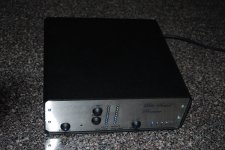I recently built an IR Remote Control that I'm pretty fond of.
It started out as me helping out Uriah Dailey by writing the firmware for an ATtiny (similar to the processor in an Arduino) microcontroller to give his LDR attenuator a remote control option. But it can also be used as a a stand-alone remote control attenuator & source switch, useful for making an (active or passive) preamp.
I chose an Analog Devices AD5206 RDAC because I have always liked the quality of Analog Devices chips. But since it uses a linear scale, I had to map the steps to a logarithmic function to create a "log pot". I also coded the device to provide left/right panning (or in the six-chanel version, left/right and front/back panning) and it does this using a constant power algorithm. The overall volume stays the same even when panning hard left or hard right. It gives a more natural balance when panning side-to-side or front-to-back.
The processor also allows for five source devices to be chosen, which I think is ample for most home theater and home hifi setups.
More details of my build with schematics and instructions are shown here:
I had front and rear panels made so the box looks nice. I chose to build my prototype using a perfboard and point-to-point wiring. But now Uriah has printed circuit boards, making assembly a whole lot easier and cleaner. You can reach him at the following URL:
A little bit about me: I design digital systems for a living, mostly in the fields of industrial control, embedded device and telephony. I have built many controllers for things like cooling towers and factory assembly lines, and I've built things like eReaders and point-of-sale systems. So this microcontroller was right up my alley. I also design loudspeakers as a hobby, and have a small company that produces them both as finished loudspeakers and as kits.
It started out as me helping out Uriah Dailey by writing the firmware for an ATtiny (similar to the processor in an Arduino) microcontroller to give his LDR attenuator a remote control option. But it can also be used as a a stand-alone remote control attenuator & source switch, useful for making an (active or passive) preamp.
I chose an Analog Devices AD5206 RDAC because I have always liked the quality of Analog Devices chips. But since it uses a linear scale, I had to map the steps to a logarithmic function to create a "log pot". I also coded the device to provide left/right panning (or in the six-chanel version, left/right and front/back panning) and it does this using a constant power algorithm. The overall volume stays the same even when panning hard left or hard right. It gives a more natural balance when panning side-to-side or front-to-back.
The processor also allows for five source devices to be chosen, which I think is ample for most home theater and home hifi setups.
More details of my build with schematics and instructions are shown here:
I had front and rear panels made so the box looks nice. I chose to build my prototype using a perfboard and point-to-point wiring. But now Uriah has printed circuit boards, making assembly a whole lot easier and cleaner. You can reach him at the following URL:
A little bit about me: I design digital systems for a living, mostly in the fields of industrial control, embedded device and telephony. I have built many controllers for things like cooling towers and factory assembly lines, and I've built things like eReaders and point-of-sale systems. So this microcontroller was right up my alley. I also design loudspeakers as a hobby, and have a small company that produces them both as finished loudspeakers and as kits.
Attachments
Last edited:
Glad to do it. I really like mine.
As I said earlier, I actually did the firmware as a request for someone else. But I liked it so much I ended up selling all my other (active and passive) preamps.
This thing is dead quiet and pure sounding, and I made the user interface as intuitive as possible.
Plus it is inexpensive and simple to build, especially with Uriah's printed circuit boards. So I really like it, and I hope you will too.
As I said earlier, I actually did the firmware as a request for someone else. But I liked it so much I ended up selling all my other (active and passive) preamps.
This thing is dead quiet and pure sounding, and I made the user interface as intuitive as possible.
Plus it is inexpensive and simple to build, especially with Uriah's printed circuit boards. So I really like it, and I hope you will too.
Wonder how the 'wipers' in the AD5206 work if not by some variable resistor arrangement. Can't be by electro-mechanical means can it?
- Status
- Not open for further replies.
